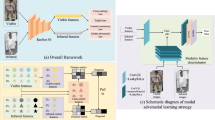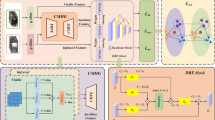Abstract
Visible-Infrared person Re-Identification (VI-ReID) is essential for public security. However, it poses a significant challenge due to the distinct reflection frequencies of visible and infrared modalities, leading to a substantial semantic gap between them. A novel modality-transform-based Dual-X method is proposed to narrow the gap between modalities. The modality generators in Dual-X will generate corresponding auxiliary modalities for both visible and infrared modalities, which is achieved through a lightweight channel-level transformation. The newly generated modality images complement the original modal information and are concatenated into the network to facilitate modality-shared and capture modality-specific features. In addition, as softmax is often overconfident on most multi-modal data, an uncertainty estimation algorithm is introduced to quantify the credibility of the model output while providing classification probabilities. By providing reliable uncertainty estimations and reducing uncertainty loss during training, the model’s predictions can be more credible. Extensive experiments were conducted, and the results demonstrated that the proposed approach outperforms state-of-the-art methods by more than 3.7% accuracy on both SYSU-MM01 and RegDB datasets, demonstrating the effectiveness of our approach.
Access this chapter
Tax calculation will be finalised at checkout
Purchases are for personal use only
Similar content being viewed by others
References
Dai, P., Ji, R., Wang, H., Wu, Q., Huang, Y.: Cross-modality person re-identification with generative adversarial training. In: IJCAI, p. 6 (2018)
Han, Z., Zhang, C., Fu, H., Zhou, J.T.: Trusted multi-view classification. arXiv preprint arXiv:2102.02051 (2021)
Hao, X., Zhao, S., Ye, M., Shen, J.: Cross-modality person re-identification via modality confusion and center aggregation. In: Proceedings of the IEEE/CVF International Conference on Computer Vision, pp. 16403–16412 (2021)
Huang, Z., Liu, J., Li, L., Zheng, K., Zha, Z.J.: Modality-adaptive mixup and invariant decomposition for rgb-infrared person re-identification. arXiv preprint arXiv:2203.01735 (2022)
Li, D., Wei, X., Hong, X., Gong, Y.: Infrared-visible cross-modal person re-identification with an x modality. In: Proceedings of the AAAI Conference on Artificial Intelligence, pp. 4610–4617 (2020)
Lu, Y., et al.: Cross-modality person re-identification with shared-specific feature transfer. In: Proceedings of the IEEE/CVF Conference on Computer Vision and Pattern Recognition, pp. 13379–13389 (2020)
Sensoy, M., Kaplan, L., Kandemir, M.: Evidential deep learning to quantify classification uncertainty. In: Advances in Neural Information Processing Systems, pp. 3183–3193 (2018)
Sun, Y., Zheng, L., Yang, Y., Tian, Q., Wang, S.: Beyond part models: person retrieval with refined part pooling (and a strong convolutional baseline). In: Ferrari, V., Hebert, M., Sminchisescu, C., Weiss, Y. (eds.) ECCV 2018. LNCS, vol. 11208, pp. 501–518. Springer, Cham (2018). https://doi.org/10.1007/978-3-030-01225-0_30
Tan, B., Song, Y., Zhong, E., Yang, Q.: Transitive transfer learning. In: Proceedings of the 21th ACM SIGKDD International Conference on Knowledge Discovery and Data Mining, pp. 1155–1164 (2015)
Wang, G., Zhang, T., Cheng, J., Liu, S., Yang, Y., Hou, Z.: Rgb-infrared cross-modality person re-identification via joint pixel and feature alignment. In: Proceedings of the IEEE/CVF International Conference on Computer Vision, pp. 3623–3632 (2019)
Wang, Z., Wang, Z., Zheng, Y., Chuang, Y.Y., Satoh, S.: Learning to reduce dual-level discrepancy for infrared-visible person re-identification. In: Proceedings of the IEEE/CVF Conference on Computer Vision and Pattern Recognition, pp. 618–626 (2019)
Ye, M., Lan, X., Li, J., Yuen, P.: Hierarchical discriminative learning for visible thermal person re-identification. In: Proceedings of the AAAI Conference on Artificial Intelligence, pp. 7501–7508 (2018)
Ye, M., Shen, J., J Crandall, D., Shao, L., Luo, J.: Dynamic dual-attentive aggregation learning for visible-infrared person re-identification. In: Vedaldi, A., Bischof, H., Brox, T., Frahm, J.-M. (eds.) ECCV 2020. LNCS, vol. 12362, pp. 229–247. Springer, Cham (2020). https://doi.org/10.1007/978-3-030-58520-4_14
Ye, M., Shen, J., Lin, G., Xiang, T., Shao, L., Hoi, S.C.: Deep learning for person re-identification: a survey and outlook. IEEE Trans. Pattern Anal. Mach. Intell. 44(6), 2872–2893 (2021)
Zhang, Q., Lai, C., Liu, J., Huang, N., Han, J.: Fmcnet: feature-level modality compensation for visible-infrared person re-identification. In: Proceedings of the IEEE/CVF Conference on Computer Vision and Pattern Recognition, pp. 7349–7358 (2022)
Author information
Authors and Affiliations
Corresponding author
Editor information
Editors and Affiliations
Rights and permissions
Copyright information
© 2024 The Author(s), under exclusive license to Springer Nature Singapore Pte Ltd.
About this paper
Cite this paper
Zhang, W., Zhang, Z., Gong, L., Zhang, J., Li, M. (2024). Credible Dual-X Modality Learning for Visible and Infrared Person Re-Identification. In: Liu, F., Sadanandan, A.A., Pham, D.N., Mursanto, P., Lukose, D. (eds) PRICAI 2023: Trends in Artificial Intelligence. PRICAI 2023. Lecture Notes in Computer Science(), vol 14327. Springer, Singapore. https://doi.org/10.1007/978-981-99-7025-4_21
Download citation
DOI: https://doi.org/10.1007/978-981-99-7025-4_21
Published:
Publisher Name: Springer, Singapore
Print ISBN: 978-981-99-7024-7
Online ISBN: 978-981-99-7025-4
eBook Packages: Computer ScienceComputer Science (R0)




